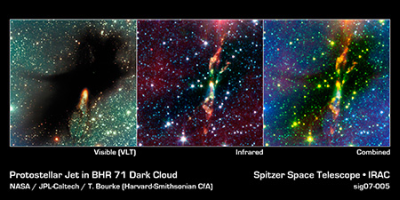14 May 2007

NASA's Spitzer Space Telescope (SST) recently produced exquisite images of distant energetic stars, erupting powerful jets into space.
The hot, young stars are located in a cosmic cloud known as BHR 71, 600 light years away from Earth. They shine as yellow point-sources, with colorful jets emanating from them. The colors of the jets represent the temperatures of the constituent gases. Hot hydrogen gas is coded green, orange shows warm gas, and the wisps of red are the coolest gas. Shockwaves from the luminous stars slam into these jets.
SST is an infrared space observatory that orbits the Sun in an Earth-trailing orbit. With sophisticated instruments, SST can observe infrared emission (or heat radiation) from space in the wavelength range 3 µm to 180 µm. (1 µm is one millionth of a meter.)
By observing the Universe in infrared, astronomers can observe planetary atmospheres, detect distant faint galaxies and peer into vast, star-forming cosmic clouds. Therefore, infrared detectors can reveal unprecedented details.
"Spitzer offers a spectacular view of this region. In space, there are only a handful of places where we can see the chemical effects of stellar outflows on the surrounding cloud and we see that in this Spitzer image," said Dr. Tyler Bourke of the Harvard-Smithsonian Center for Astrophysics (CfA).
The high-energy shockwaves impact the gas particles with a tremendous momentum, so the gas nearest the stars is the hottest. Collisions further out are less violent. This is because some of the energy of the shockwave is dissipated due to interaction with the particles.
"Astronomers believe that all young stars at this stage of evolution [or development] produce jets. However, we do not always see these jets because they need a dense environment -- with a lot of gas and dust -- to run into," said Bourke. "We also need infrared telescopes to measure heat created when the jets' shockwaves collide with gas molecules."
For years, stars embedded deep within BHR 71 have evaded detection in visible-light. In an optical image taken by the ground-based Very Large Telescope (VLT), BHR 71 is just a large, dark cloud. Only a yellowish glow in BHR 71 hints the existence of the veiled, rapidly evolving stars.
Astronomers speculated that this optical effect was due to a hot, young star's powerful jet streaming through the dense structure. This prediction was verified when scientists acquired the visible-light view of BHR 71 and Spitzer's infrared view (right panel). In this composite image, the visible-light jet is coincident with a jet flowing from the star to the left, in the infrared image.
The image also reveals a "crowd" of stars that are invisible in optical images. Yellow dots scattered throughout the image are young stars forming inside BHR 71. Spitzer also uncovered another erupting star, located close to the right of the energetic star seen in the visible light image.
Bourke is the principal author of a research article on BHR 71, which is due for publication.
SST is the largest infrared observatory ever launched into space. It was launched on 25 August 2003. The observatory consists of an infrared telescope, 0.85 m in aperture, with infrared detectors that are capable of acquiring images and recording spectra of cosmic objects.
Spitzer is a technological masterpiece. Scince infrared is primarily heat radiation, the telescope must be cooled to near absolute zero (-273 degrees Celsius) so that it can observe infrared signals from space without interference from the telescope's own heat. It is the last mission of NASA's Great Observatories Program.
Further Reading
SST
http://www.spitzer.caltech.edu/spitzer/index.shtml
NASA's Great Observatories
http://www.spitzer.caltech.edu/about/greatobs.shtml
Aymen Mohamed Ibrahem
Senior Astronomy Specialist